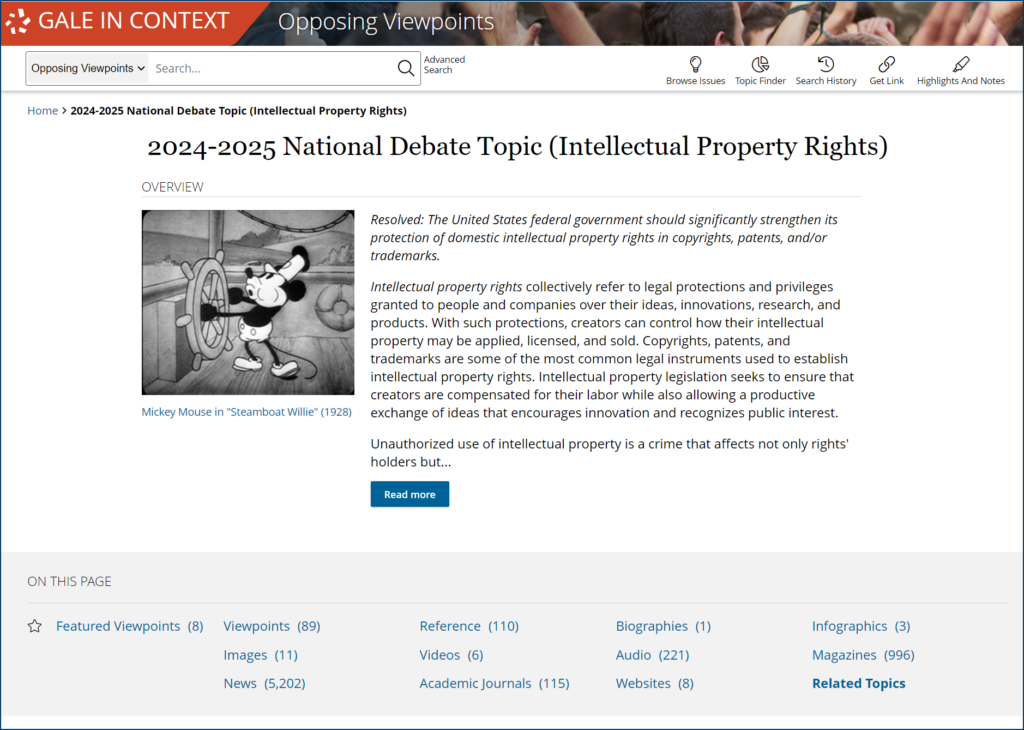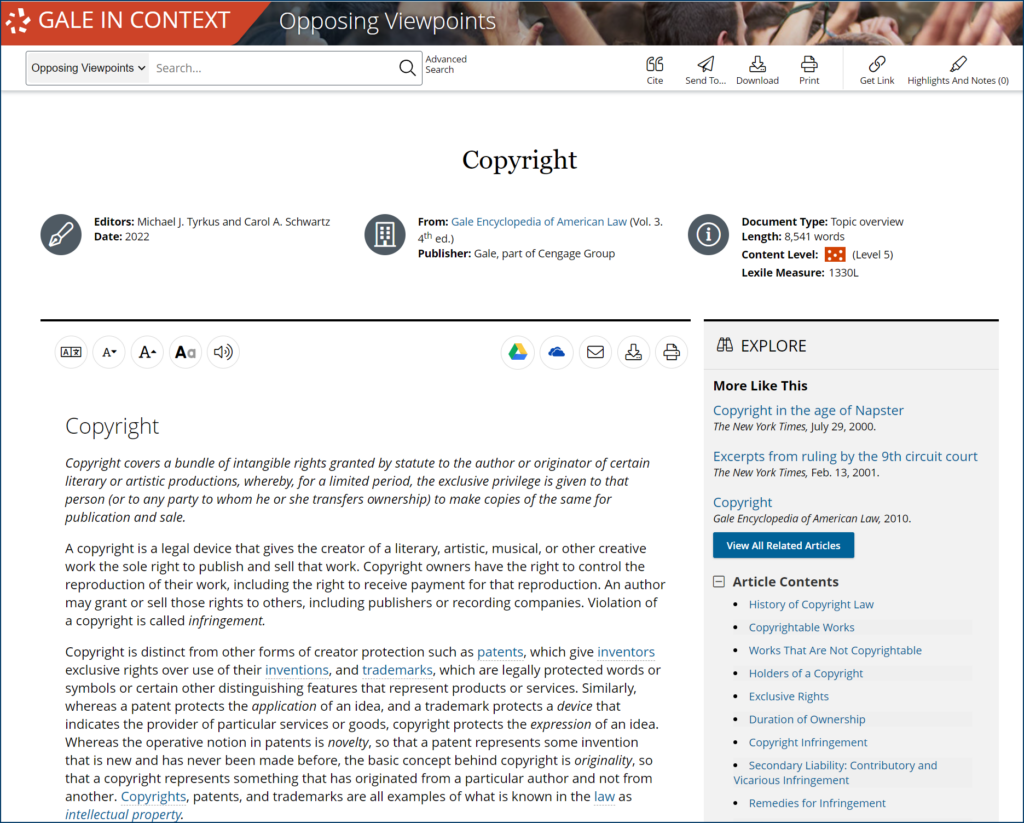From August 2–4, 10,000 high school students will converge on Iowa for an intense three-day showdown, all aiming to emerge victorious in the National Policy Debate on Intellectual Property Rights (IPR). Hosted by the National Federation of State High School Associations (NFHS), this highly anticipated event promises to be a thrilling test of rhetoric and a masterclass in effective persuasion.
As voted on by more than 40 states and national organizations, this year’s prompt is: “The United States federal government should significantly strengthen its protection of domestic intellectual property rights in copyrights, patents, and/or trademarks.”
Given the recent developments involving copyright law and AI content, this year’s topic seems particularly pertinent, as it naturally raises questions about what’s considered an original creation and a derivative work.
The New York Times, for example, has taken legal action against Microsoft and OpenAI for allegedly using their content without authorization in AI training. Getty Images is embroiled in a high-stakes legal battle with Stability AI over similar issues. Even independent creators are calling for action, with a group of artists filing a lawsuit against AI-generated art platforms for exploiting their work without permission and threatening their livelihood by capitalizing on their distinctive art styles to create “new” images.
High schoolers will soon have a say in this new world of copyright legislation, so what better time for them to grapple with this quandary? The resources available on Gale In Context: Opposing Viewpoints include engaging real-world examples so educators can inspire grounded, evidence-supported discussions about the future of intellectual property rights.
Cover the Basics of Intellectual Property Rights
Most students likely understand the meaning of copyright at a surface level, but they need a more in-depth understanding of intellectual property rights to formulate educated, evidence-supported opinions on its uses. Given the amount of jargon and legislation surrounding it, this topic can easily become overwhelming. Students need teacher-led instruction at this phase of the learning journey, and Gale is here to help you make sense of it all.
The 2024–2025 National Debate portal on the Opposing Viewpoints platform is rich in reference pages and resources that present these concepts in a reader-friendly way, making it an excellent first stop for lesson planning.
Consider breaking down intellectual property rights into more digestible concepts by starting with the basics: patents, copyrights, and trademarks. This gives students a chance to ask questions and clear up any misunderstandings or misconceptions. It’s also an opportunity to assess which students may need additional support on the fly so they’re better prepared for more in-depth discussions and activities later.
Patents
What do the internal combustion engine (1898), a device for moistening postage stamps (1981), and a snake-repellent system (2001) have in common? They each have registered patents!
When an inventor patents their creation, it gives them exclusive property rights to use, sell, or manufacture the invention for a specific period—usually 20 years.
Extending the Lesson With Gale In Context: Opposing Viewpoints
Once students understand the basics of patents, it may be helpful to consider the topic in a wider context and how it impacts the world around them.
- Introduce real instances of patent case law, including the arguments and outcomes of those cases.
- Dive into the history of patents and other intellectual property rights and the implications for the future.
- Discuss the possible motivations behind patent trolls, or people and companies “that aggressively pursue patent infringement suits, usually with no intention of manufacturing or marketing the patent itself.”
Copyrights
Copyrights apply to original artistic and literary works, such as books, movies, ballets, etc., but they have a limited lifespan depending on when the copyright was issued.
All copyrights prior to January 1, 1978, have a maximum duration of 95 years from the publication date, which is why we see properties like Winnie the Pooh (1926) and “Steamboat Willie” (1928) entering the public domain. If granted a copyright after January 1, 1978, the creator has exclusive rights to reproduce, distribute, perform, or display the work for the creator’s lifetime plus 70 years. Fair use exceptions also exist that allow for commentary, criticism, and parody.
Extending the Lesson With Gale In Context: Opposing Viewpoints
Copyright is particularly relevant to students because it’s incredibly easy to accidentally participate in intellectual property theft without even realizing it’s wrong—like listening to an audiobook on YouTube instead of paying for it, or posting a picture of someone else’s art on Instagram without their permission.
- Explain complex copyright law concepts in simpler terms with the copyright overview page.
- Learn about intellectual property theft and how it impacts the entertainment industry.
- Consider different perspectives with two Viewpoints essays, “Fashion Designers Need Copyright Protection” and “Fashion Designers Do Not Need Copyright Protection.”
Trademarks
Brands rely on creating their own distinct identities to stand out from their competitors. To accomplish this, they need trademarks for things like symbols, words, or phrases that distinguish their goods and services. Trademark examples vary widely, from the word Coca-Cola to the Nike Swoosh logo and Geico’s gecko—even the smell of Play-Doh has its own trademark!
You can use a simple demonstration to show how much a trademark influences our perceptions of that brand and even competing products in the market.
Show students a facial tissue, adhesive bandage, and cotton swab, then ask them to name each item. There’s a good chance they’ll respond with Kleenex, Band-Aid, and Q-Tip. This phenomenon is called genericization, or when a trademarked name is so ubiquitous that it becomes synonymous with describing the general product or service.
Extending the Lesson With Gale In Context: Opposing Viewpoints
- Read through an interesting trademark case in which Taco Bell filed a petition with the U.S. Patent and Trademark Office to cancel competing chain Taco John’s trademark on the phrase “Taco Tuesday.” Their justification is that the term “should belong to all who make, sell, eat, and celebrate tacos.”
Activity: Use Models to Develop Argumentative Writing
Students new to argumentative writing may need help knowing where to start when it comes time to take a stance on intellectual property rights. Instead of jumping right into the deep end, provide additional scaffolding using exemplars first. These models of effective argumentative writing support students by showcasing effective arguments and evidence usage.
To make reviewing exemplars more active and engaging for learners, teachers may want to consider flipping the assignment. That is, rather than asking them to gather evidence to construct an argument, give them a well-constructed argument that needs evidence to support the claim.
Not only will this remove some of the cognitive load of argumentative writing, it’s also an excellent opportunity to practice using research tools like Gale’s 2024–2025 National Debate Topic portal. With the platform’s user-friendly search function, learners can efficiently find content that supports views from either side of the debate using keywords from the provided exemplar arguments.
Below, we’ve provided an example of what this activity might look like in the classroom, including a real-world case study to provide context.
Case Study: Sky TV and Hello Games
In 2013, British broadcasting company Sky TV took legal action against several companies, including Hello Games, the studio behind No Man’s Sky. The core of the dispute was Sky TV’s claim that the use of “sky” in the game’s title infringed on their trademark of the word. They had previously won out against much larger companies, including Microsoft, who rebranded their cloud storage platform as “OneDrive” from “SkyDrive” after Sky TV pursued legal action.
To keep their title, Hello Games—a small studio trying to develop a AAA-level game with a team of 17 people—had to settle with Sky TV, whose revenue topped $7 billion in 2013, for an undisclosed amount after a multi-year legal battle.
Argument for Strong Intellectual Property Rights
Sky TV’s actions reassure other companies that they, too, can protect their branding efforts through trademark law. They invested money, time, and resources into building their brand. Allowing other companies to use similar names would only dilute their brand recognition or, in a worst-case scenario, lead to their name being associated with controversial or negatively viewed brands.
Argument Against Strong Property Rights
Overly strict intellectual property rights can stifle innovation and disproportionately harm smaller companies with limited resources. In the case of Hello Games, this legal battle illustrates how powerful corporations can use their extensive legal resources to intimidate and financially burden smaller entities. Enforcing such a broad trademark enables large corporations to bully other businesses into relinquishing their share of the market, no matter how small it may be.
Opposing Viewpoints: An Unbiased Resource for Arguing Any Side of an Issue
As innovation increasingly seems at odds with the things that make us distinctly human—creativity, emotion, values, and more—students will continue to encounter ethical dilemmas about the challenges and responsibilities we have when dealing with topics like data privacy, digital citizenship, and, of course, intellectual property rights. The National Policy Debate taking place August 2–4 gives real-world context to approach these discussions in your curriculum.
Rather than relying on the often skewed resources available through Google search results, look to Gale In Context: Opposing Viewpoints. The platform’s range of trusted materials offers your learners informed, differing views to support their critical thinking skills and help them draw their own conclusions.



